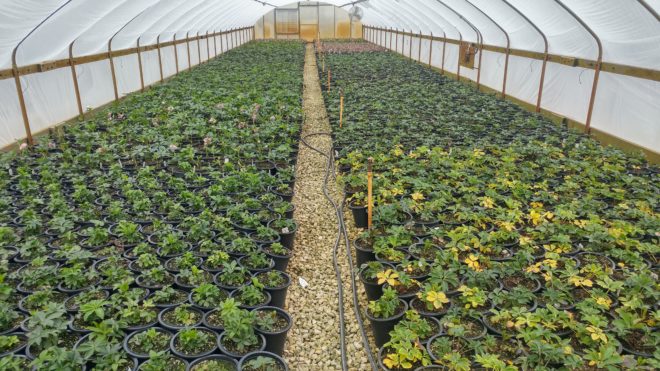Doug Heindel & Peter Gordon share how we keep our plants healthy during the winter months!
At Millcreek, we pride ourselves on growing high quality plants, people, and relationships. Many people ask us, “How do you overwinter your plant crops so that they are flourishing next season?” While every situation is different, there are a few basics that will go a long way to increase your overwintering success.
Without a doubt, the most important factor in the overwintering process is the health of the plant material going into winter. Unhealthy, poorly rooted plants will likely only decline throughout the course of the winter and the overwintering success of these plants will be limited. The hard work tending to our plants throughout the summer and fall seasons is crucial to having success the following spring.
As the days get shorter and the temperatures get colder, the perennials will go naturally into winter dormancy. Once this happens, it is time to get those perennials covered up for the winter.
At Millcreek, we cover our 95+ huts with a double layer of polyethylene film. These huts are then heated throughout the winter using natural gas, kept to a temperature just above freezing. This ensures our plants are exposed to a consistent temperature that keeps them from being damaged by excessive cold. Once our huts are covered, our teams are able to spend a good majority of the winter getting those perennials cut back and cleaned up so they are ready to go when spring arrives.
If you don’t have access to a polyhut you can still overwinter your perennials and have great success doing so. Prior to covering them, we would recommend that the plants are cut back and cleaned up so they are ready for their cold winter nap. Once they are cleaned, nest them together pot to pot, side by side, not on top of one another. Cover them with frost blankets followed by a layer of white reflective polyfilm, which will both reflect the heat and keep the frost blanket dry. Secure the plastic with concrete blocks (or similar), ensuring that the root zone of the plant material is completely covered. A common mistake that is made is only covering the tops of the plants, leaving the root zone completely exposed. The root zone is actually the most crucial piece of the overwintering puzzle so be sure to be extra diligent in keeping it protected. Along with that, you’ll want to water your perennials thoroughly prior to packing them away. Water is a great insulator and will further protect that root zone.
You’ll also want to bait for rodents prior to covering the plants. Place traps every 15-20 feet to help reduce the rodent population and ensure they don’t wreak havoc on your overwintered perennials. If you’re overwintering ornamental grasses, you may want to increase the amount of bait as rodents seem to love them.
Now that your perennials are covered, walk away, and leave them alone until spring. Covering/uncovering will cause greater temperature fluctuations than if you just left them alone. Once the spring season begins to arrive, it will be important to keep a close eye on the temperature. You don’t want to leave the plants covered too long but you also don’t want to expose them to temperatures under 25°F.
This is a quick overview of simple ways to overwinter your perennials. As always, if you have any questions in regards to overwintering, please be sure to reach out to your friends at Millcreek Gardens, we’ll be happy to assist.


